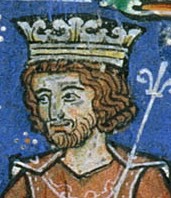
Amalric or Amaury I was King of Jerusalem from 1163, and Count of Jaffa and Ascalon before his accession. He was the second son of Melisende and Fulk of Jerusalem, and succeeded his older brother Baldwin III. During his reign, Jerusalem became more closely allied with the Byzantine Empire, and the two states launched an unsuccessful invasion of Egypt. He was the father of three future rulers of Jerusalem, Sibylla, Baldwin IV, and Isabella I.

The Kingdom of Jerusalem, also known as the Latin Kingdom, was a Crusader state that was established in the Levant immediately after the First Crusade. It lasted for almost two hundred years, from the accession of Godfrey of Bouillon in 1099 until the siege of Acre in 1291. Its history is divided into two periods with a brief interruption in its existence, beginning with its collapse after the siege of Jerusalem in 1187 and its restoration after the Third Crusade in 1192.

Baldwin III was the king of Jerusalem from 1143 to 1163. He was the eldest son of Melisende and Fulk of Jerusalem. He became king while still a child, and was at first overshadowed by his mother Melisende, whom he eventually defeated in a civil war. During his reign Jerusalem became more closely allied with the Byzantine Empire, and the Second Crusade tried and failed to conquer Damascus. Baldwin captured the important Egyptian fortress of Ascalon, but also had to deal with the increasing power of Nur ad-Din in Syria. He died childless and was succeeded by his brother Amalric.
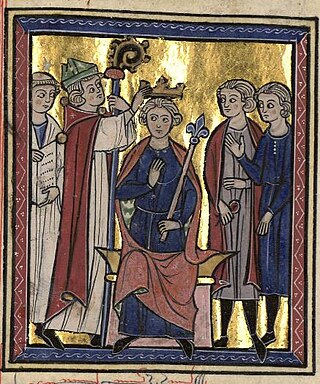
Foulques V d'Anjou Roi de Jérusalem
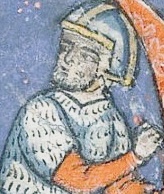
Nūr al-Dīn Maḥmūd Zengī, commonly known as Nur ad-Din, was a member of the Zengid dynasty, which ruled the Syrian province of the Seljuk Empire. He reigned from 1146 to 1174. He is regarded as an important figure of the Second Crusade.
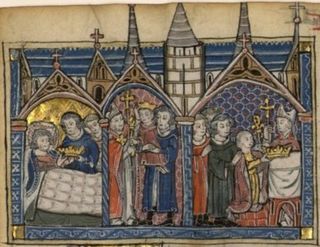
Raymond III was count of Tripoli from 1152 to 1187. He was a minor when Nizari Assassins murdered his father, Raymond II of Tripoli. Baldwin III of Jerusalem, who was staying in Tripoli, made Raymond's mother, Hodierna of Jerusalem, regent. Raymond spent the following years at the royal court in Jerusalem. He reached the age of majority in 1155, after which he participated in a series of military campaigns against Nur ad-Din, the Zengid ruler of Damascus. In 1161 he hired pirates to pillage the Byzantine coastline and islands to take vengeance on Byzantine emperor Manuel I Komnenos, who had refused to marry his sister Melisende. He was captured in the Battle of Harim by Nur ad-Din's troops on 10 August 1164, and imprisoned in Aleppo for almost ten years. During his captivity, Amalric I of Jerusalem administered the county of Tripoli on his behalf.

The Kingdom of Jerusalem, one of the Crusader states that was created in 1099, was divided into a number of smaller seigneuries. According to the 13th-century jurist John of Ibelin, the four highest crown vassals in the kingdom proper were the count of Jaffa and Ascalon, the prince of Galilee, the lord of Sidon, and the lord of Oultrejordain.

The Battle of Ascalon took place on 12 August 1099 shortly after the capture of Jerusalem, and is often considered the last action of the First Crusade. The crusader army led by Godfrey of Bouillon defeated and drove off a Fatimid army, securing the safety of Jerusalem.
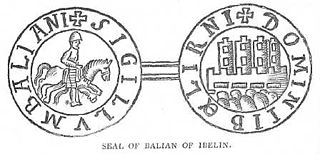
Balian of Ibelin, also known as Barisan the Younger, was a crusader noble of the Kingdom of Jerusalem in the 12th century. He was lord of Ibelin from 1170 to 1193. As the leader of the defense of the city during the siege of Jerusalem in 1187, he surrendered Jerusalem to Saladin on 2 October 1187.

The Battle of al-Babein took place on March 18, 1167, during the third Crusader invasion of Egypt. King Amalric I of Jerusalem, and a Zengid army under Shirkuh, both hoped to take the control of Egypt over from the Fatimid Caliphate. Saladin served as Shirkuh’s highest-ranking officer in the battle. The result was a tactical draw between the forces, however the Crusaders failed to gain access to Egypt.
Abū Muḥammad ʿAbd Allāh ibn Yūsuf ibn al-Ḥāfiẓ, better known by his regnal name al-ʿĀḍid li-Dīn Allāh, was the fourteenth and last caliph of the Fatimid dynasty, and the twenty-fourth imam of the Hafizi Isma'ili branch of Shi'a Islam, reigning from 1160 to 1171.

A series of Crusader invasions of Egypt were undertaken by the Kingdom of Jerusalem from 1163 to 1169 to strengthen its position in the Levant by taking advantage of the weakness of the Fatimid Caliphate.
The military history of the Crusader states begins with the formation of the County of Edessa in 1097 and ends with the loss of Ruad in 1302, the last Christian stronghold in the Holy Land.
Saladin arrived in Egypt in 1163 and ruled it from 1171 until his death in 1193. Egypt was in a state of decay prior to Saladin's rise to power with the political and social situation in shambles. Saladin first arrived in Egypt alongside his uncle Shirkuh on a campaign launched by Nur al-Din. He would rise to prominence under Shirkuh eventually succeeding him as vizier of Egypt. When the Fatimid Caliphate fell in 1171, Saladin was the only remaining authority in Egypt, he would use his increased power and independence to expand his realm and influence.
Abu'l-Hasan Ali al-Adil ibn al-Sallar or al-Salar, usually known simply as Ibn al-Sal[l]ar, was a Fatimid commander and official, who served as the vizier of Caliph al-Zafir from 1149 to 1154. A capable and brave soldier, Ibn al-Sallar assumed senior gubernatorial positions, culminating in the governorship of Alexandria. From this position in 1149 he launched a revolt, along with his stepson Abbas ibn Abi al-Futuh. Defeating the army of the then vizier, Ibn Masal, he occupied Cairo and forced the young Caliph al-Zafir to appoint him vizier instead. A mutual disdain and hatred bound the two men thereafter, and the Caliph even conspired to have Ibn al-Sallar assassinated. During this tenure, Ibn al-Sallar restored order in the army and strove to halt Crusader attacks on Egypt, but with limited success. He was assassinated at the behest of his ambitious stepson Abbas, who succeeded him as vizier.
Tala'i ibn Ruzzik was a military commander and official of the Fatimid Caliphate, serving as its vizier from 1154 until his assassination in 1161, when he was succeeded by his son, Ruzzik ibn Tala'i. He is generally acknowledged as the last of the powerful and capable viziers of the Fatimid state. During his tenure the Fatimid Caliphate regained a measure of stability, and was once again able to project its power abroad and pursue its political interests in the Eastern Mediterranean.

The timeline of the Kingdom of Jerusalem presents important events in the history of the Kingdom of Jerusalem—a Crusader state in modern day Israel and Jordan—in chronological order. The kingdom was established after the First Crusade in 1099. Its first ruler Godfrey of Bouillon did not take the title of king and swore fealty to the Latin Patriarch of Jerusalem, Daimbert. Godfrey's brother and successor Baldwin I was crowned the first king of Jerusalem without doing homage to the patriarch in 1100. By 1153, Baldwin I and his successors captured all towns on the Palestinian coast with the support of Pisan, Genoese and Venetian fleets and also took control of the caravan routes between Egypt and Syria. The kings regularly administered other crusader states—the Counties of Edessa and Tripoli and the Principality of Antioch—on behalf of their absent or underage rulers.
Abu'l-Ashbāl al-Ḍirghām ibn ʿĀmir ibn Sawwār al-Lukhamī was an Arab military commander in the service of the Fatimid Caliphate. An excellent warrior and model cavalier, he rose to higher command and scored some successes against the Crusader Kingdom of Jerusalem as well as against internal rebellions. Despite his close personal ties to the viziers Tala'i ibn Ruzzik and his son Ruzzik ibn Tala'i, he joined Shawar when the latter rebelled against Ruzzik and seized the vizierate. Nine months later, Dirgham betrayed Shawar as well and expelled him from the capital, becoming vizier himself on 31 August 1163. Amidst yet another Crusader invasion in 1164, Dirgham clashed with Shawar, who had gained the support of Syrian troops led by Shirkuh. Deserted by most of his troops, Dirgham was killed sometime in May–August 1164 by Shawar's army.

The siege of Acre took place in May 1104. It was of great importance for the consolidation of the Kingdom of Jerusalem, which had been founded only a few years earlier. With the help of a Genoese fleet, King Baldwin I forced the surrender of the important port city after a siege that lasted only twenty days. Although all defenders and residents wishing to leave the city had been assured by the king that they would be free to leave, taking their chattels with them, many of them had been massacred by the Genoese as they left the city. Moreover, the attackers had also sacked the city itself.













